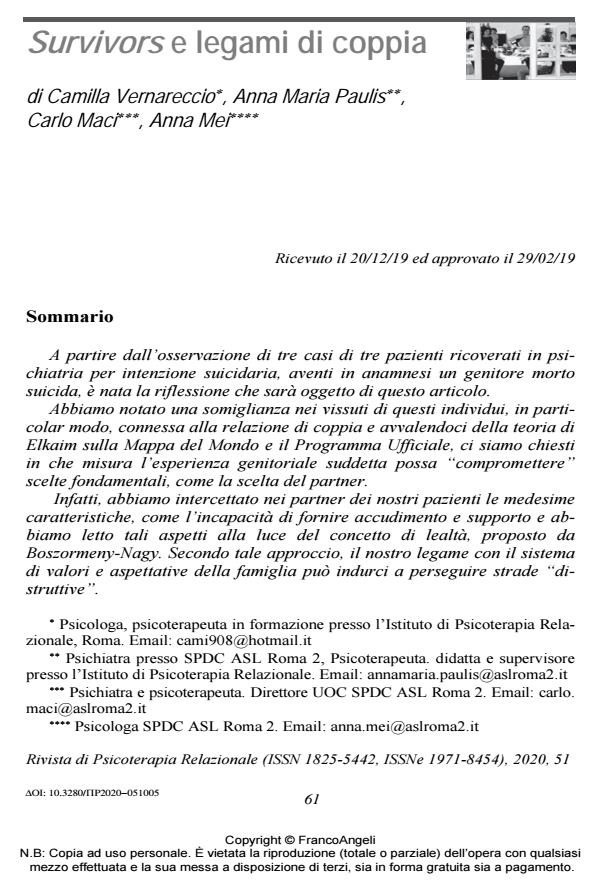Survivors e legami di coppia
Titolo Rivista RIVISTA DI PSICOTERAPIA RELAZIONALE
Autori/Curatori Camilla Vernareccio, Anna Maria Paulis, Carlo Maci, Anna Mei
Anno di pubblicazione 2020 Fascicolo 2020/51
Lingua Italiano Numero pagine 11 P. 61-71 Dimensione file 215 KB
DOI 10.3280/PR2020-051005
Il DOI è il codice a barre della proprietà intellettuale: per saperne di più
clicca qui
Qui sotto puoi vedere in anteprima la prima pagina di questo articolo.
Se questo articolo ti interessa, lo puoi acquistare (e scaricare in formato pdf) seguendo le facili indicazioni per acquistare il download credit. Acquista Download Credits per scaricare questo Articolo in formato PDF

FrancoAngeli è membro della Publishers International Linking Association, Inc (PILA)associazione indipendente e non profit per facilitare (attraverso i servizi tecnologici implementati da CrossRef.org) l’accesso degli studiosi ai contenuti digitali nelle pubblicazioni professionali e scientifiche
A partire dall’osservazione di tre casi di tre pazienti ricoverati in psichiatria per intenzione suicidaria, aventi in anamnesi un genitore morto suicida, è nata la riflessione che sarà oggetto di questo articolo. Abbiamo notato una somiglianza nei vissuti di questi individui, in particolar modo, connessa alla relazione di coppia e avvalendoci del-la teoria di Elkaim sulla Mappa del Mondo e il Programma Ufficiale, ci siamo chiesti in che misura l’esperienza genitoriale suddetta possa "compromettere" scelte fondamentali, come la scelta del partner. Infatti, abbiamo intercettato nei partner dei nostri pazienti le mede-sime caratteristiche, come l’incapacità di fornire accudimento e sup-porto e abbiamo letto tali aspetti alla luce del concetto di lealtà, pro-posto da Boszormeny-Nagy. Secondo tale approccio, il nostro legame con il sistema di valori e aspettative della famiglia può indurci a per-seguire strade "distruttive".
Parole chiave:Ideazione suicidaria, genitore suicida, relazione di coppia, scelta del partner, lealtà, mappa del mondo, programma uffi-ciale, survivors.
- Boszormenyi-Nagy I., Spark G.M. (1988). Lealtà invisibili: la reciprocità nella terapia familiare intergenerazionale. Roma: Astrolabio.
- Elkaïm M. (1992). Se mi ami, non amarmi: orientamento sistemico e psicoterapia. Torino: Bollati Boringhieri.
- Mitchell A.M., Sakraida T.J., Kim Y., Bullian L., Chiappetta L. (2009). Depression, anxiety and quality of life in suicide survivors: A comparison of close and distant relationships. Archives of Psychiatric Nursing, 23(1): 2-10.
- Pompili M., Tatarelli R. (2010). La prevenzione del suicidio in psicoterapia. Roma: Alpes.
- Castellano R., Velotti P., Zavattini G.C. (2010). Cosa ci fa restare insieme. Bologna: il Mulino.
- Loriedo C., Di Giusto M., De Bernardis G. (2011). Attrazione e scelta: incontrarsi e formare una coppia. Milano: Ponte alle Grazie.
- Vella G., Solfaroli Camillocci D. (1992). Né con te, né senza di te: la coppia in stallo. Roma: Il pensiero scientifico.
- McIntosh J.L. (1993). Control group studies of suicide survivors: A review and critique. Suicide and Life‐Threatening Behavior, 23(2): 146-161.
- Schreiber J.K., Sands D.C., Jordan J.R. (2017). The perceived experience of children bereaved by parental suicide. OMEGA-Journal of Death and Dying, 75(2): 184-206. DOI: 10.1177/003022281561229
- Mitchell A.M., Kim Y., Prigerson H.G., Mortimer-Stephens M. (2004). Complicated grief in survivors of suicide. Crisis, 25(1): 12-18. DOI: 10.1027/0227-5910.25.1.1
- Shneidman E.S. (2001). Comprehending suicide. Landmarks in 20th-century suicidology. Crisis, 22(02): 79-79. DOI: 10.1027//0227-5910.22.2.7
Camilla Vernareccio, Anna Maria Paulis, Carlo Maci, Anna Mei, Survivors e legami di coppia in "RIVISTA DI PSICOTERAPIA RELAZIONALE " 51/2020, pp 61-71, DOI: 10.3280/PR2020-051005